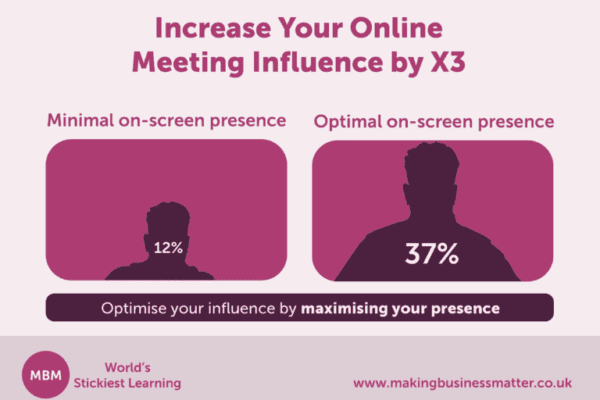How to Build Rapport Virtually
The pandemic has changed many things. The main thing at work is meetings. We can’t do it like we used to. This means we need to adapt. And one of the crucial things in adapting is building rapport virtually. It might be a new client, a new colleague or just finding a better way to get close to your team.
Let’s start with ‘what is rapport?’
Apparently it is this:
‘A close and harmonious relationship in which the people or groups concerned understand each other’s feelings or ideas and communicate well.’
Using the lasso tool, we would put a ring around ‘relationship’, ‘feelings’ and ‘communicate’.
So, we need to build a relationship by understanding how each of us feels and communicate well too. Easy?
No.
I am not a fan of small talk. Never have been. Never will be. The ‘but’ is that I have come to appreciate that without it it can just feel like robots bumping into each all day long as we meet and speak. So, a little knowledge about who they are, what drives them, and why, adds interest to the day and feels more human, than robot. Plus, from a purely merciless point of view, people that respect, trust and like people, will do more for them, than those they don’t.
Virtual Meetings Have Polarised Us
My own experience of virtual meetings is those that were poor meeting people before are 10 times worse, and those that were good seem 10 times better. Virtual meetings have polarised us. People that bored us before when they presented make us want to eat the stapler in frustration, and those that we look forward to before, now we actively think of joining the ABC project when it is nothing to do with us!

Yesterday, I was pitching to a new client. ‘Building rapport’ was running through my head, and I was trying to think of ways to do it virtually. Make them laugh I thought. I made the joke early on in the meeting that the problem with virtual meetings is that it is much harder to slip £20 under the table. Thankfully they laughed. Me: Score 1 for rapport.
Equally, a few weeks ago a prospect meeting went the other way. I tried to build a rapport. They were all, ‘Let’s get to this as I have another meeting I need to get to’. I tried the ‘You must be busy – why so busy?’. And received the looks, gestures, and mutterings of ‘pandemic’ and was ushered to just start. Me: Score 0 for rapport.
The point is that it will not always work. Of course, it won’t. Your challenge is to make it work more than it does now. These tips, tricks and tools will help.
Let’s take a look at 3 ways we can become one of the good ones…
The Trusty Old Trust Model
Whenever we talk about people, work, relationships, it’s like watching a favourite tv programme that you’ve seen before. You know what you’re going to get, but there’s always something you missed before. Another watch won’t hurt. And might just be good for the soul. There are 4 parts to the trust model:
- Credibility: He knows his stuff.
- Reliability: She always delivers on time.
- Intimacy: We know a bit about each other.
- Self-Orientation: I talk a lot about myself.
Think about someone who you don’t trust – I bet you can identify one element from the trust equation that they fail to deliver. Where do you let yourself down? And what can you do to improve how much you are trusted?

Rapport is a lot about the third part of the equation ‘Intimacy’, something which adds a new layer of challenges when building virtually. However, don’t worry British men, we don’t have to hug people unless you want to (Oh no, it’s virtual. Bad luck!). This part of the equation is about how much I know about you and how much you know about me. Remember not to trip into self-orientation where it is all about you.

If you want to improve the intimacy part, the Push/Pull Influencing technique is excellent.
The Push and Pull Influencing Technique
Watch this 1-minute video to understand this very effective influencing technique:

Then, use this technique to either offer information about you – Push:
- ‘Last weekend we had Wayne’s birthday’.
- ‘Tonight we are out for a curry with his Mum and Dad’.
- ‘Saw a great programme called ‘Peaky Blinders – seen it?’.
- ‘I’ve just learnt my MBTI or HBDI profile – what do you think I am?’.
Or use this technique to either gain information about them – Pull:
- ‘How are your kids’ managing being schooled at home?’.
- ‘Holiday plans this year?’.
- ‘What’s going on in your world?’.
- ‘I’m looking for a good book to read – know any?’.
You don’t need much information to build intimacy. Just some to create a foundation.
Paraphrasing Shows Active Listening
Everyone wants to be heard. Paraphrasing, or repeating back the last few words of what they have said, demonstrates that you are listening and listening well. When looking to build rapport virtually, this is so important because the non-verbal cues that help us to understand whether someone is engaged no longer exist. So, we need to provide more obvious cues to show that we are listening.
As Dale Carnegie wrote in his famous book, ‘How to Win Friends and Influence People‘, be present. Often we are talking to someone and their eyes move to something that is of more interest. When I am speaking with one of my children and they receive a text, and must read it…drives me nuts! The same is true for meetings, 121’s. Be present. Make them your whole world.
Label Emotions
If you have ever seen the tv programme ‘Catchphrase’ – it’s a little like that. Say what you see/hear. ‘You sound like you’re having a tough day’, or ‘You seem very busy – how can I help?’. Addressing what you hear and see might just help deal with the emotional elephant in the room.

N.L.P.
‘Neuro-linguistic programming is a pseudoscientific approach to communication, personal development, and psychotherapy created by Richard Bandler and John Grinder in California, United States, in the 1970s.’
In other words, a manual for the brain, or a way of leapfrogging to be a better you by copying the behaviours of others. Who do you know that is good at building rapport? Then, what one thing can you ‘pinch with pride’ from them to help you to build rapport virtually?




